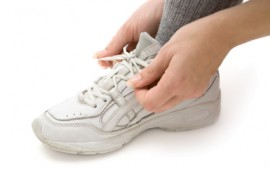Get the Right Fit Every Time!
Author: Shannon Miller

Do you pull out your cute but painful shoes or the old pair that’s falling apart?
Finding the right pair of running shoes is critical to your performance and injury prevention.
So we went to ask the experts at a Jacksonville-based running store – 1st Place Sports for advice on picking the perfect pair.
We’ve got several great tips for you plus a short word on this running barefoot business!
First, let’s check out some buying tips:
1. If you need help with picking out the best running shoe, it is best to go to a running specialty store, where their staff (fit specialists) are knowledgeable runners. Their insight and experience in fitting running shoes will be well worth the trip.
2. Feet have different shapes and operate in lots of different ways. Therefore, seeking a running friend’s advice about the best running shoe is NOT the best policy.
3. Make sure you get both feet measured for length and width. Also, have your feet analyzed for arch height and have the mobility of your ankle examined. This analysis is the only way to get the proper running shoe.
4. Once your feet have been analyzed you should be put into one of four categories.
a. neutral
b. slight pronator
c. over pronator
d. severe pronator
**Pronation is the inward roll of the foot during the weight bearing phase or the foot strike cycle. A pronator is a person who has a tendency to roll too far inside.
5. You should then try on three to four shoes (recommended from staff) in that category. You are now looking for the best fit based on the width and volume of your foot. Comfort is very important. Do the following checks to make sure you are fitted correctly:
a. Length check – you need 1/2 inch of space past your longest toe – your foot will expand when it lands on the ground when running so leave room for the expansion. Make sure you stand up when testing for length.
b. Width check – move your forefoot from side to side to make sure that the shoes have a little extra width for your foot to expand when running. Not much, but a small amount of space. If your foot feels like it hangs over the insole, then the shoe is too narrow. The laces of the shoe can also tell a story about the proper width. The laces should appear to be about the same width from the bottom to the top. If the laces get farther apart as you go up the lace system, then the shoe is too narrow. If the laces get closer together as you go up the lace system, then the shoe is too wide.
6. It is best to either try your shoes out on a treadmill (usually found in a specialty running store) or take them out for a short jog on the sidewalk (this is the best test). The fit specialist should watch you run on the shoe to verify that the shoe is performing as expected.
7. Make sure to get a technical running sock to go with the shoes. Wearing ill fitting socks that are not moisture wicking can cause blisters.
As far as the trend of running barefoot goes, our running specialist said the following:
Barefoot running on soft surfaces can be a tool to help runners strengthen the muscles in their feet. Short 100 to 200 yard jogs on grass is a good training technique. Running barefoot or in shoes like the Five Finger Vibrams or the New Balance Minimalist (shoes with zero heel lift and no cushioning) are never recommended for running on pavement of sidewalks.
TIP: There you have it – every detail of information that you need to know about buying running shoes! Now, go visit a running specialty store to get just the right fit for you!
Our thanks to 1st Place Sports for sharing this helpful information.
